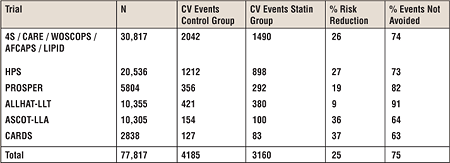Clinical Insights in Targeting Hypertriglyceridemia to Reduce Cardiovascular Risk
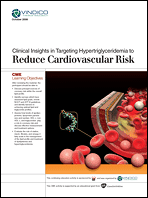
Assessing Biomarkers of Atherosclerosis Triglycerides and CHD Risk: Fasting and
Non-Fasting Current Concepts in the Management of Patients
with Hypertriglyceridemia |
Introduction
Elevated low-density lipoprotein (LDL) cholesterol is recognized as the most important lipid factor contributing to atherosclerosis. However, cardiovascular events are common even among people with LDL cholesterol levels in the normal range (90 to 130 mg/dL). A significant association has been demonstrated between elevated triglycerides and increased coronary risk. Results from a secondary prevention study have demonstrated reductions in coronary heart disease (CHD) risk with low on-treatment triglycerides (<150 mg/dL) and LDL cholesterol (<70 mg/dL). The National Cholesterol Education Program (NCEP) Adult Treatment Panel III (ATP III) provides some guidance for management of hypertriglyceridemia and recognizes serum triglycerides as a marker for both atherogenic lipoproteins and metabolic syndrome. This continuing education monograph is based on a satellite symposia that occurred at the 2008 National Lipid Association Annual Scientific Sessions. It will provide a discussion of biomarkers of atherosclerosis, focusing on triglycerides and their usefulness in predicting cardiovascular risk, it will discuss current concepts in the management of hypertriglyceridemia, and provide an overview of results from clinical trials of lipid-lowering agents.
|
Assessing Biomarkers of Atherosclerosis
Michael Miller, MD, FACC, FAHALDL Cholesterol and CHD Risk
LDL cholesterol is one of the most important risk factors influencing the development of atherosclerosis.1 A strong association has been established between very high levels of LDL (>200 mg/dL) and risk of CHD. However, development of atherosclerosis is also relatively common among people with LDL levels considered to be in the normal range (90 to 130 mg/dL).2 Indeed, only 20% of CHD events occur among the 10% of the population with the highest LDL levels.3 The average LDL level among American adults is estimated at 123 mg/dL,4 and rates of subclinical atherosclerosis are as high as 40% to 50% among men and women by the end of their sixth decade.5 Thus, an argument can be made that this average for LDL can not be considered normal. Indeed, no evidence of atherosclerosis is found among modern populations of hunter-gatherers with estimated total and LDL cholesterol level about half that of average levels for total and LDL cholesterol seen in American adults.
These observations bolster the argument that atherosclerosis is a disease of civilization, resulting from patterns of nutrition and activity that are at odds with our genetically determined biology. Lipid levels among healthy newborns give us perhaps the best indication of what normal levels should be throughout life. At birth, total and LDL cholesterol levels average 70 and 30 mg/dL, respectively with total cholesterol increasing to 100 to 150 mg/dL between the first and second years of life LDL 50 to 70 mg/dL.1, 6, 7
Figure
1. Relative risk for coronary heart disease (log scale).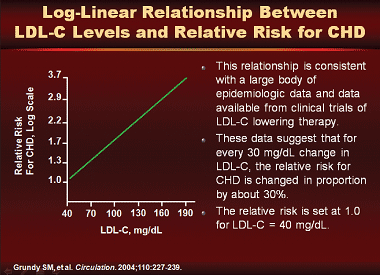 |
The log-linear relationship between LDL cholesterol and relative risk for CHD in the general population has been established on the basis of extensive data from epidemiologic studies and clinical trials of lipid-lowering medications. As shown in Figure 1, the relative risk of CHD is set at 1.0 for an LDL level of 40 mg/dL, with CHD risk increasing by about 30% for every increase in LDL of 30 mg/dL.8 Results from trials of statin therapies have consistently shown that risk of CHD events decreases as levels of LDL decrease.1, 9-16 Furthermore, the relationship between lowering LDL levels and reducing CHD risk extends well below what is considered the normal range for LDL in adult populations.1
Reducing Residual Risk
As demonstrated in Table 1, rates of CHD among patients who received statin therapy in major treatment studies further demonstrate the benefits of decreasing LDL concentrations.9 CHD rates in these studies were lowered on average by about 25%. However, significant numbers of CHD events continued to occur in all of these prevention trials, indicating that even after successfully lowering LDL with statin therapy (ie, < 70 mg/dL), residual CHD risk persists. Therefore, it remains to be determined how we might attain additional clinical benefit beyond LDL lowering. One possibility is to lower triglycerides. Although controversy exists as to whether triglycerides represent an independent CHD risk factor or biomarker, there is little question that elevated levels are associated with increased CHD risk. To this end, a recent meta-analysis of 29 clinical trials conducted in over 262,525 men and women demonstrated that people in the upper tertile for triglycerides exhibited a 70% greater risk for incident CHD when compared with the lower tertile even after controlling for gender, fasting status, and HDL (Figure 2).14
| Table
1: Cardiovasclular event* rates in major prevention studies
*Nonfatal MI/CHD death; AFCAPS also included unstable angina; CARDS included coronary/stroke/revascularization events. |
Triglycerides and Lipid Subfractions: Role in Atherogenesis
Despite the importance of triglycerides as markers of CHD risk, triglycerides themselves are not atherogenic. Triglycerides are broken down and hydrolyzed to free fatty acids, which are used directly as an energy source or stored in adipocytes. Remnant lipoproteins, the downstream products of hydrolyzed triglyceride-rich lipoproteins, are atherogenic. These cholesterol-enriched products can traverse through the subendothelium, taking on characteristics that are similar to LDL that has been modified. They enhance adhesion molecule expression, macrophage chemotaxis, and other proinflammatory cellular effects. Remnant particles have been shown to be present in the atheromatous plaque.15 Data from the Honolulu Heart Study of 1,156 middle-aged men followed for over a decade showed very strong correlations between log-transformed levels of fasting triglycerides and remnant lipoprotein cholesterol (r=0.88; P<0.01).16. Even adjusting for both HDL and LDL, remnant lipoprotein cholesterol still remained independently associated with increased CHD risk. However, this association did not hold when adjusting for triglycerides due to the tight correlation between the two substances,16 suggesting that elevated triglycerides can serve as a biomarker of increased levels of atherogenic remnant particles.
The uptake of both the VLDL and oxidized LDL has been shown to trigger a proinflammatory cascade, with VLDL—particularly apolipoprotein CIII-containing VLDL particles—demonstrated to be particularly atherogenic. Therefore, in patients with mixed hyperlipidemia (high levels of oxidized LDL and VLDL or VLDL-CIII-containing proteins) the atherogeneic process is accelerated and risk for CHD is increased. A recent report on an Amish family with apolipoprotein CIII gene a nonsense mutation in the hypotriglyceridemia provides some human evidence CIII deficiency states may be associated with reduced CHD risk.17
Figure
2. Coronary heart disease (CHD) event rates in secondary prevention
trials.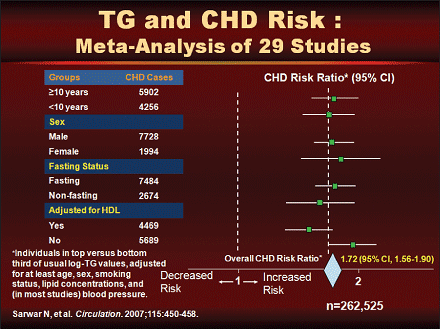 |
Benefits of Reduced Triglyceride Levels
A recent statement from the American Diabetes Association (ADA) and the American Heart Association (AHA) reiterated that elevated LDL cholesterol is the primary target of lipid-lowering therapy, with the goal of reducing LDL concentrations to <100 mg/dL and to b <70 mg/dL in high-risk patients. The ADA also recognizes elevated levels of triglyceride-rich lipoproteins as a secondary target of lipid-lowering therapy, with the goal of reducing triglyceride levels below 150 mg/dL. Neither the AHA nor the NCEP endorse a therapeutic triglyceride reduction goal. Instead, the AHA advocates lowering non-HDL cholesterol concentrations to <130 mg/dL in patients with triglyceride levels ranging from 200 to 499 mg/dL.18 One potential concern related to these recommendations is whether by targeting non-HDL cholesterol as a secondary target for lipid-lowering therapy we are over-emphasizing LDL to the exclusion of other lipids and atherogenic lipoproteins in high risk patients. For instance, if a high-risk patient has achieved LDL (<70 mg/dL) and non-HDL target goals, but still has elevated triglycerides, is there still significant residual risk for CHD?
Analysis of results from the Pravastatin or Atorvastatin Evaluation and Infection Therapy-Thrombolysis in Myocardial Infarction (PROVE IT-TIMI) 22 trial have shed some light on this question. PROVE IT-TIMI 22 randomized 4,162 patients who were hospitalized for acute coronary syndrome (ACS) to daily doses of atorvastatin 80 mg or pravastatin 40 mg and demonstrated that reduction of LDL cholesterol < 70 mg/dL was associated with greater CHD event reduction than LDL-Ca < 100 mg/dL.19 A separate analysis of data from the study examined whether reducing triglycerides <150 mg/dL in addition to maintaining LDL cholesterol concentration <70 mg/dL might further reduce risk for CHD events.20 Blood sampling for lipids, lipoproteins, high-sensitivity C-reactive protein (CRP) was performed at baseline, 30 days, and 4, 8, 16, and 24 months. The composite endpoint was death, myocardial infarction (MI), or recurrent ACS between the 30 day and the 24 month follow-up. Univariate analysis demonstrated a significant reduction in risk of CHD events for both LDL cholesterol levels <70 mg/dL and triglyceride levels <150 mg/dL.
The ratios hazard(HR) of death, MI, and recurrent ACS, separately by LDL cholesterol and triglyceride level after one month of treatment for patients who achieved on-treatment triglyceride levels <150 mg/dL and LDL cholesterol levels <70 mg/dL were lower compared with a referent group with higher triglyceride ≥150 mg/dL and LDL cholesterol ≥70 mg/dL (HR 0.72, 95% confidence interval [CI] 0.54 to 0.94; P=0.017) (Figure 3). Other combinations of LDL cholesterol triglyceride levels above and below the target thresholds were evaluated, but the only group that had significantly reduced CHD risk after adjusting for covariates was the group with the combination of low on-treatment LDL and low on-treatment triglycerides.20 Various lipids and lipoproteins were also examined as continuous variables in unadjusted and adjusted analysis. Unadjusted risk estimates showed that each 10 mg/dL decrease in LDL cholesterol and non-HDL cholesterol was associated with a 4% and 4.8% reduction in hazard, respectively (P<0.01), while a similar 10 mg/dL reduction in triglyceride level was associated with a 1.8% reduction in CHD risk (P<0.001). With covariate adjustment, reduction in triglyceride level was the only variable with a statistically significant association with CHD risk (P<0.001, adjusted for LDL cholesterol; P=0.01, adjusted for non-HDL cholesterol).
Figure
3. PROVE IT Trial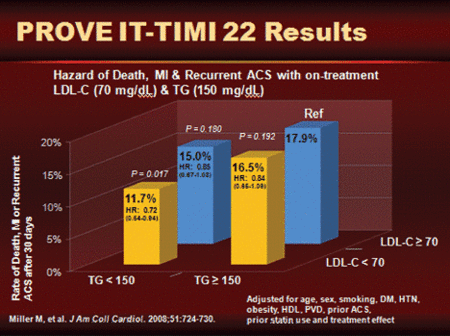 |
Summary
Triglycerides are a recognized, universally measured marker of CHD risk and an excellent surrogate for atherogenic remnants. Recent data from the PROVE IT-TIMI 22 trial found that low on-treatment triglycerides (ie,<150 mg/dL) in combination with low on-treatment LDL cholesterol (ie, <70 mg/dL) reduced CHD risk beyond reduction in LDL cholesterol alone, raising the possibility that high risk patients may benefit from a combined strategy aimed at low LDL cholesterol and triglycerides to maximize CHD risk reduction. Whetber this will be considered in future guidelines however, will be dependent upon prospective trials that demonstrate clinical benefit with triglyceride lowering that extends beyond LDL reduction.
References
- O’Keefe JH, Cordain L, Harris WH, Moe RM, Vogel R. Optimal low-density lipoprotein is 50 to 70 mg/dL: Lower is better and physiologically normal. J Am Coll Cardiol. 2004;43:2142-2146.
- Akosah KO, Schaper A, Cogbill C, Schoenfeld P. Preventing myocardial infarction in the young adult in the first place: how do the national cholesterol education panel iii guidelines perform? J Am Coll Cardiol. 2003;41:1475-1479.
- Law MR, Wald NJ. Risk factor thresholds: their existence under scrutiny. BMJ. 2002;324:1570-1576.
- Carroll MD, Lacher DA, Sorlie PD, et al. Trends in Serum Lipids and Lipoproteins of Adults, 1960-2002. JAMA. 2005;294:1773-1781.
- Jaffer FA, O’Donnell CJ, Larson MG, et al. Age and Sex Distribution of Subclinical Aortic Atherosclerosis: A Magnetic Resonance Imaging Examination of the Framingham Heart Study. Arterioscler Thromb Vasc Biol. 2002;22:849-854.
- Berenson GS, Blonde CV, Farris RP, et al. Cardiovascular disease risk factor variables during the first year of life. Am J Dis Child. 1979;133:1049-1057.
- Kwiterovich PO, Jr. Biochemical, clinical, epidemiologic, genetic, and pathologic data in the pediatric age group relevant to the cholesterol hypothesis. Pediatrics. 1986;78:349-362.
- Grundy SM, Cleeman JI, Merz CN, et al. Implications of recent clinical trials for the National Cholesterol Education Program Adult Treatment Panel III guidelines. Circulation. 2004;110:227-239.
- MRC/BHF Heart Protection Study of cholesterol lowering with simvastatin in 20[punctuation space]536 high-risk individuals: a randomised placebocontrolled trial. Lancet. 2002;360:7-22.
- Cannon CP, Braunwald E, McCabe CH, et al. Intensive versus Moderate Lipid Lowering with Statins after Acute Coronary Syndromes. N Engl J Med. 2004;350:1495-1504.
- Sacks FM, Pfeffer MA, Moye LA, et al. The effect of pravastatin on coronary events after myocardial infarction in patients with average cholesterol levels. Cholesterol and Recurrent Events Trial investigators. N Engl J Med. 1996;335:1001-1009.
- Scandinavian Simvastatin Survival Study G. Randomised trial of cholesterol lowering in 4444 patients with coronary heart disease: the Scandinavian Simvastatin Survival Study (4S). Lancet. 1994;344:1383-1389.
- The Long-Term Intervention with Pravastatin in Isc24.Imke C, Rodriguez BL, Grove JS, et al. Are remnant-like particles independent predictors of coronary heart disease incidence? The Honolulu Heart study. Arterioscler Thromb Vasc Biol. 2005;25:1718-1722.
- Sarwar N, Danesh J, Eiriksdottir G, et al. Triglycerides and the Risk of Coronary Heart Disease: 10 158 Incident Cases Among 262 525 Participants in 29 Western Prospective Studies. Circulation. 2007;115:450-458.
- Doi H, Kugiyama K, Oka H, et al. Remnant Lipoproteins Induce Proatherothrombogenic Molecules in Endothelial Cells Through a Redox-Sensitive Mechanism. Circulation. 2000;102:670-676.
- Imke C, Rodriguez BL, Grove JS, et al. Are remnant-like particles independent predictors of coronary heart disease incidence? The Honolulu Heart study. Arterioscler Thromb Vasc Biol. 2005;25:1718-1722.
- Pollin TI, Damcott CM, Shen H, Ott SH, Shelton J, Horenstein JB. Novel APOC3 nonsense mutation 21 R19X in the old order Amish causes hypotriglyceridemia and blunted postprandial triglyceride response [Oral presentation]. Oral Presentation at Arteriosclerosis, Thrombosis and Vascular Biology Annual Conference 2008. Atlanta, GA. April 16-18, 2008. Abstract 21.
- Buse JB, Ginsberg HN, Bakris GL, et al. Primary prevention of cardiovascular diseases in people with diabetes mellitus: a scientific statement from the American Heart Association and the American Diabetes Association. (ADA/ AHA STATEMENT: Reviews/Commentaries/ADA Statements). Diabetes Care. 2007;30:162(111).
- Cannon CP, Braunwald E, McCabe CH, et al. Intensive versus Moderate Lipid Lowering with Statins after Acute Coronary Syndromes. N Engl J Med. 2004;350:1495-1504.
- Miller M, Cannon CP, Murphy SA, Qin J, Ray KK, Braunwald E. Impact of Triglyceride Levels Beyond Low-Density Lipoprotein Cholesterol After Acute Coronary Syndrome in the PROVE IT-TIMI 22 Trial. J Am Coll Cardiol. 2008;51:724-730.
Triglycerides and CHD Risk: Fasting and Non-Fasting
Karol E. Watson, MD, PhD, FACCTrigylceride-Rich Lipoproteins
There are many different lipoproteins, varying in shape, composition, and size. We focus on LDL cholesterol because of its direct association with atherosclerosis and cardiovascular risk but do not afford as much attention to the triglyceride-rich lipoproteins and their role in CHD. As a group they are very variable in size, ranging from large chylomicrons to small remnant particles. Currently, the extent to which the size and composition influence the atherogenic potential of these lipoproteins is unclear. VLDL particles are predominantly triglyceride-containing lipoproteins whereas remnant particles, such as IDL, are smaller, contain less triglyceride and are more cholesterol and phospholipid enriched. Large chylomicrons and VLDL particles are unable to enter the arterial intima and, therefore, may pose less atherogenic risk. By contrast, smaller VLDL and IDL particles are able to penetrate the arterial intima and are associated with the presence and progression of atherosclerosis.
The association between triglyceride levels and CHD risk is well established. Data from Framingham Heart Study, looking at both men and women, show that triglyceride levels above 150 mg/dL are associated with increased relative risk of CHD (Figure 1).1 A meta-analysis of results from 29 trials evaluating the relationship between triglyceride levels and coronary risk demonstrated that people in the upper tertile for triglycerides face over 70% increased risk for coronary events compared with those in the lower tertile.2 Moreover, this increased risk conferred by elevated triglycerides appears to be independent of LDL and HDL cholesterol level. The Prospective Cardiovascular Münster (PROCAM) study evaluated 4849 middle-age men with low LDL cholesterol level (<130 mg/dL) and higher LDL cholesterol levels (>190 mg/dL) and found that, regardless of LDL cholesterol level, elevated triglycerides (>200 mg/dL) were associated with increased CHD risk.3 This risk was particularly high among people with LDL cholesterol >160 mg/dL, but even in people with LDL cholesterol <130 mg/dL, elevated triglyceride levels were associated with a two-fold increase in CHD events. Similarly, the Copenhagen Male Study, which followed 2906 middle age men for 8 years, demonstrated that elevated triglycerides conferred increased CHD risk even in the presence of HDL cholesterol levels considered to be protective of CHD risk (Figure 2).4 Even where HDL cholesterol levels ranged from 57 to 134 mg/dL there was a significant trend in greater incidence of CHD among people with triglycerides in the middle (97 to 141 mg/dL) and upper (141 to 198 mg/dL) tertiles.4
Figure
1. Framingham Heart Study: relationship between triglycerides and
CHD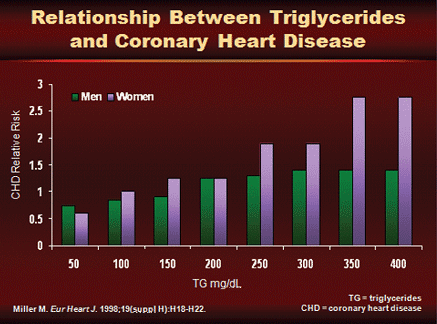 |
Primary and Seconary Hypertriglyceridemia
There are numerous primary and secondary causes of hypertriglyceridemia. Primary causes include familial combined hypertriglyceridemia, familial dysbetalipoproteinemia, familial hypertriglyceridemia, and familial chylomicronemia. Familial combined hypertriglyceridemia occurs in approximately 1% to 2% of the population, and is associated with elevated LDL, VLDL, and apolipoprotein B levels.5, 6 Triglycerides levels usually range from 150 to 500 mg/dL in people with familial combined hypertriglyceridemia and the condition is associated with premature coronary disease.5 Familial dysbetalipoproteinemia occurs less commonly, with a prevalence ranging from 0.2% to 1.0%. It results from a mutation in the apolipoprotein E gene which causes defective binding of remnant lipoproteins to receptors, leading to impaired remnant degradation. For full expression of this phenotype, apolipoprotein E mutation as well as another condition such as familial combined hyperlipidemia, obesity, or diabetes associated with over-secretion of VLDL is required. Familial dysbetalipoproteinemia is associated with triglyceride and total cholesterol levels ranging from 300 to 400 mg/dL, with normal HDL cholesterol levels.6 Familial hypertriglyceridemia is commonly seen and occurs in people who have a family history of elevated VLDL cholesterol with or without elevated chlomicrons. It is associated with normal LDL cholesterol and apoprotein B levels as well as low HDL cholesterol levels and triglycerides range from 250 to 1000 mg/dL. People with familial hypertriglyceridemia are at increased risk for pancreatitis, which may occur as early as the teen years, and, to a lesser extent, CHD.5, 6 Familial chylomicronemia is rare condition arising from a defect in lipoprotein lipase or apolipoprotein CII. It is associated with extremely high triglyceride levels from birth ranging from 1,000 to 10,000 mg/dL. People with familial chylomicronemia often present with eruptive xanthomas and recurrent pancreatitis, but face no increased risk for atherosclerosis.5
Hypertriglyceridemia more commonly results from secondary causes, including lifestyle factors (eg, physical inactivity, high dietary carbohydrate intake, and excessive alcohol intake), diseases or conditions (eg, obesity, metabolic syndrome, diabetes), and use of certain medications (eg, estrogen replacement therapy, tamoxifen) The majority of cases of hypertriglyceridemia result from lifestyle factors and medical conditions resulting from lifestyle. Therefore, changes in lifestyle have become a mainstay in the treatment of hypertriglyceridemia.
Figure
2. Copenhagen Male Study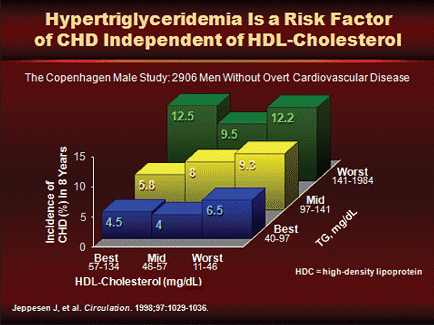 |
Fasting versus Non-Fasting Triglycerides
The most dramatic change in lipoproteins that occurs with eating occurs in the triglyceride-rich lipoproteins. Results from a study investigating the effects of triglyceride-rich lipoproteins on endothelial activation following eating found that patients with normal triglyceride levels experienced a slight increase in triglycerides about 2 hours following a meal, with levels returning to normal within about 8 hours after eating (Figure 3). In subjects with hypertriglyceridemia, the increase in triglyceride levels was more dramatic and prolonged, peaking about 4 hours after a meal and not returning to baseline levels until after 8 hours. Triglyceride levels after eating were associated with endothelial dysfunction as measured by brachial artery flow-mediated vasoreactivity. Patients with normal triglyceride levels experienced a nadir in endothelial function at about 2 to 4 hours after eating. Function rapidly returned to normal thereafter, with patients experiencing peaks in endothelial function above normal at 6 and 8 hours. By contrast, patients with hypertriglyceridemia experienced a much more severe nadir in endothelial function, which continued to drop through 6 hours and failed to normalize by 8 hours.7
These data raise the question as to why lipids are routinely measured in a fasting state, particularly because the majority of each day is spent in the post absorptive state. On average, during the day we are only really fasting for the 6- to 8-hour period during which we are asleep. Historically, triglycerides have been measured in the fasting state because there is a marked increase in triglycerides after ingestion of food and fat, leading to a wide variability in measurements. Additionally, before the availability of direct assays for LDL cholesterol measurement, estimation of LDL cholesterol was performed by using the Friedewald formula, which requires a fasting triglyceride value. It is important to recognize that the practice of measuring triglycerides in the fasting state did not derive from prospective clinical trials and may actually potentially lead to underestimating the impact of hypertriglyceridemia on CHD risk.
The graph in Figure 4 illustrates the effect of eating on various lipoproteins at 2 and 4 hours after a meal. No change in LDL or HDL cholesterol level is evident at either time point. However, there is a marked increase in triglyceride-rich remnant lipoproteins at both 2 and 4 hours compared with baseline. Two recent studies have evaluated the role of non-fasting triglycerides in cardiovascular risk. The first examined a cohort of 26,509 initially healthy US women who took part in the Women’s Health Study. Triglyceride levels were measured in blood samples obtained at time of enrollment, with fasting triglycerides measured in 20,118 subjects and non-fasting triglycerides measured in 6,391 subjects. The median follow-up was 11.4 years. Patients in the fasting and non-fasting groups were divided into tertiles based on triglyceride level and hazard ratios were determined for each tertile, adjusting for age, blood pressure, smoking, hormone therapy use, HDL cholesterol, diabetes mellitus, body mass index, and C-reactive protein. For the group with fasting lipid measurements, there was no significant trend in cardiovascular risk according to increasing triglyceride level, indicating that fasting triglyceride levels were not predictive of future cardiovascular risk. By contrast, for patients in the non-fasting group, there was a large and statistically significant increase in cardiovascular risk between the highest and lowest tertile for triglycerides. The association between non-fasting triglycerides and risk was strongest in subjects who had blood taken 2 to 4 hours after a meal.8
Figure
3. Effects of triglyceride-rich lipoproteins on endothelial cell
function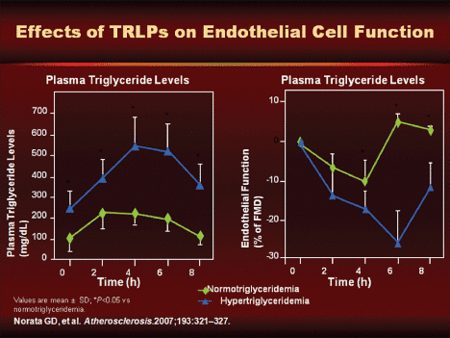 |
Similar findings were reported in the Copenhagen Study, a long-term (mean follow-up: 26 years) prospective study in which non-fasting triglyceride levels were measured in 7,587 women and 6,394 men, aged 20 to 93 years of age.9 During follow-up, 1,793 participants experienced an MI, 3,479 developed ischemic heart disease, and 7,818 died. The cumulative incidence of MI, ischemic heart disease, and death increased significantly with increasing non-fasting triglyceride levels among both male and female participants (P<0.001). Among female participants, the risk of MI and total mortality, adjusting for age or HDL cholesterol or both, increased significantly with increased non-fasting triglyceride level. For each 1 mmol/l increase in triglycerides there was roughly a 46% increase in the risk of MI and a 26% increase in the risk of total mortality. A similar pattern was observed among male participants, although the association between increased triglycerides levels and risk was not as strong. Among men, each 1 mmol/l increase in triglycerides was associated with a 16% increase in risk for total mortality and a 10% increase in risk for MI.9
Results from the Women’s Health Study demonstrate a significant difference between non-fasting and fasting triglycerides in terms of predicting cardiovascular risk and suggest that fasting triglycerides may actually underestimate cardiovascular risk. Findings from both the Women’s Health Study and the Copenhagen Study demonstrate that non-fasting triglyceride measurements may be useful in predicting future cardiovascular risk and should be considered as endpoints in future studies. Postprandial lipid testing would have to be done in a systematic manner with meal or drink containing standardized fat, carbohydrate, and protein composition, with lipid measurements recorded over time, in a manner similar to a glucose tolerance test. However, the difficulty of conducting testing in this manner may represent a major obstacle to routine use of standardized postprandial lipid measurements. Because we spend most of our time in a non-fasting state, in addition to non-fasting triglycerides, measurements of non-HDL cholesterol after a standardized meal might also provide the best measure of the range of atherogenic lipoproteins and remnant particles that are present after eating. Some clinics have adopted a very aggressive approach to managing lipids, obtaining measurements in patients in both a fasting and non-fasting state and setting LDL cholesterol goals <70 mg/dL and fasting and non-fasting triglyceride goals of 100 mg/dL and 150 mg/dL, respectively, in high-risk patients. Non-fasting measurements are also used in some clinics for assessment of risk, while fasting measurements are used for treatment decisions. One misconception that persists in primary care is that elevated non-fasting triglycerides (eg, 400 mg/dL) should be discarded because they overestimate the patient’s fasting level. On the contrary, such a high non-fasting level should be viewed with concern because such elevations are extremely unlikely to occur in the setting of a normal fasting triglyceride level. Hence, if the cut point defining normal fasting triglycerides (<150 mg/dL) is similarly applied to non-fasting levels, patients with non-fasting triglycerides exceeding 200 mg/dL would be considered for therapy in order to reduce and maintain levels below 150 mg/dL throughout the day. Again, prospective studies would need to determine whether maintaining low postprandial triglyceride levels ultimately translates into clinical benefit.
Figure
4. Time-dependent changes in the lipoproteins after eating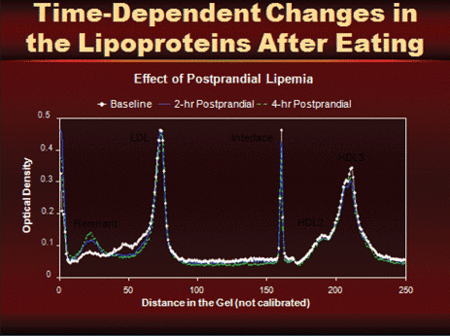 |
Summary
Results from a number of studies demonstrate that hypertriglyceridemia is an independent risk factor for CHD. Hypertriglyceridemia may result from primary causes, such as familial hypertriglyceridemia and familial dysbetalipopproteinaemia, and secondary causes, including lifestyle factors (eg, physical inactivity, dietary factors), various diseases and health conditions (eg, obesity, diabetes), and medication use (eg, estrogen replacement therapy, tamoxifen). In patients with hypertriglyceridemia, triglyceride-rich lipoproteins seem to impair endothelial function to a greater extent in a postprandial non-fasting state than they do in a fasting state. In addition, results from both the Women’s Health Study and the Copenhagen Study indicate that non-fasting triglyceride measurements are more predictive of future CHD risk than fasting triglycerides. These results raise the question of whether the current 8 to 12 hour fasting convention should be replaced with a non-fasting blood collection protocol (eg, 2 to 4 hours after a representative meal) with the goal of improving cardiovascular risk prediction.
References
- Miller M. Is hypertriglyceridaemia an independent risk factor for coronary heart disease? The epidemiological evidence. Eur Heart J. 1998;19 Suppl H:H18-22.
- Sarwar N, Danesh J, Eiriksdottir G, et al. Triglycerides and the Risk of Coronary Heart Disease: 10 158 Incident Cases Among 262 525 Participants in 29 Western Prospective Studies. Circulation. 2007;115:450-458.
- Assmann G, Schulte H, Funke H, von Eckardstein A. The emergence of triglycerides as a significant independent risk factor in coronary artery disease. Eur Heart J. 1998;19 Suppl M:M8-14.
- Jeppesen Jo, Hein HO, Suadicani P, Gyntelberg F. Triglyceride Concentration and Ischemic Heart Disease : An Eight-Year Follow-up in the Copenhagen Male Study. Circulation. 1998;97:1029-1036.
- Dunbar RL, Rader DJ. Demystifying triglycerides: a practical approach for the clinician. Cleve Clin J Med. 2005;72:661-666.
- Hachem SB, Mooradian AD. Familial dyslipidaemias: an overview of genetics, pathophysiology and management. Drugs. 2006;66:1949-1969.
- Norata GD, Grigore L, Raselli S, et al. Post-prandial endothelial dysfunction in hypertriglyceridemic subjects: Molecular mechanisms and gene expression studies. Atherosclerosis. 2007;193:321-327.
- Bansal S, Buring JE, Rifai N, Mora S, Sacks FM, Ridker PM. Fasting compared with nonfasting triglycerides and risk of cardiovascular events in women. JAMA. 2007;298:309-316.
- Nordestgaard BG, Benn M, Schnohr P, Tybjaerg-Hansen A. Nonfasting triglycerides and risk of myocardial infarction, ischemic heart disease, and death in men and women. JAMA. 2007;298:299-308.
Current Concepts in the Management of Patients with Hypertriglyceridemia
Alan S. Brown, MD, FACCConflicting evidence from various studies has fueled the debate concerning whether triglycerides can be considered an independent risk factor for CHD. Results from the Women’s Health Study and the Copenhagen Study have both shown that non-fasting triglycerides are predictive of cardiovascular risk,1, 2 while the Honolulu Heart Study demonstrated correlations between levels of fasting triglycerides and remnant lipoprotein cholesterol and between remnants and CHD risk.3 Despite conflicting evidence, elevated triglycerides tend to be associated with increased incidence of cardiovascular events. The question then is how best to approach the management of hypertriglyceridemia.
Targeting Lipid Subfractions Other Than LDL cholesterol
It is widely acknowledged based on data from both clinical and epidemiologic studies that the primary lipid target in reducing risk of cardiovascular events is LDL cholesterol.4-6 After the goal of reducing LDL cholesterol, results from epidemiologic studies suggest that increasing HDL cholesterol concentrations will have the greatest impact in risk reduction,7, 8 greater than lowering triglyceride levels. After HDL cholesterol, triglycerides may be the next key lipid target. Non-HDL cholesterol also appears to be an excellent secondary goal as it reflects both VLDL and LDL cholesterol.9 Additionally, clinical trials have provided evidence that apolipoprotein B independently predicts cardiovascular risk and correlates with non-HDL cholesterol.10
According to NCEP ATP III guidelines, the primary target of lipid-lowering therapy should be LDL cholesterol, with intensity of therapy depending on level of risk. Optimally, LDL cholesterol levels should be below 100 mg/dL. If the LDL cholesterol goal is reached and triglyceride levels are ≥200 mg/dL (often a sign of metabolic syndrome), a secondary goal for reduction of non-HDL cholesterol 30 mg/dL higher than LDL goal should be set.9,11 The advantage of non-HDL cholesterol as a secondary lipid target for reduction of cardiovascular risk is that it is easy to measure (total cholesterol minus HDL cholesterol) and it is linearly proportional to apolipoprotein B, which has been shown to be a strong predictor of risk of cardiovascular events.12
Triglycerides and CHD Risk
The 2001 NCEP ATP III guidelines recognized hypertriglyceridemia as a risk factor for cardiovascular disease and set treatment goals for very high levels. They defined triglyceride levels as normal (<150 mg/dL), borderline-high (150 to 199 mg/dL), high (200 to 499 mg/dL), and very high (≥500 mg/dL). They recognized that very high triglyceride levels (≥500 mg/dL) were associated with risk for pancreatitis and CHD and recommended lowering triglycerides as a primary treatment goal. However, unlike the ADA, which recommended keeping triglyceride levels below 150 mg/dL, with the exception of very high triglycerides and the risk for pancreatitis and CHD, the NCEP guidelines focused on lowering LDL and non-HDL cholesterol in patients with elevated triglycerides (Table 1).11, 17
People with low HDL and high triglycerides face the highest risk for cardiovascular events. Therefore, treatment—whether it be with aspirin or statin therapy—tends to result in the greatest benefit in these patients. In clinical trials of statin therapy, these are the patients who tend to drive clinical benefit. Results from AFCAPS/TexCAPS and the TNT study demonstrate that increased HDL cholesterol reduces cardiovascular risk in patients with normal and low levels of LDL cholesterol.14, 15 In addition, the Copenhagen Male Study showed that elevated triglyceride levels were associated with increased CHD risk even in the presence of high HDL cholesterol levels.18, 19 Over the 8-year follow-up period of the PROCAM study, both low HDL cholesterol levels (<40 mg/dL) and elevated triglycerides (>166 mg/dL) were associated with more than a two-fold increase in risk over normal levels.18 These results linking elevated triglycerides with increased risk take on even greater importance when seen in the larger context of the ratio between LDL and HDL cholesterol. Results from this study demonstrated that while patients with an LDL/HDL cholesterol ratio of >5 had a 19.2% risk of having a CHD event in the next 8 years, that risk rose to 26.9% in patients who also had hypertriglyceridemia.18 These results, like those from other studies such as the Helsinki Heart Study, show clearly the importance of examining the inter-relation of various lipids in determining cardiovascular risk.
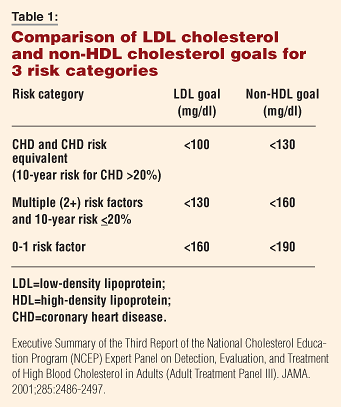
Clinical Studies of Lipid-Lowering Combination Therapies
A variety of combination therapies are effective in reducing serum triglyceride levels. These include combinations of statin therapy with niacin, fibrates, and prescription omega-3 fatty acids. Results from primary and secondary prevention studies demonstrate that, in addition to lowering triglyceride levels, these combinations provide additive benefits in reducing LDL cholesterol and augmenting HDL cholesterol levels beyond those seen with statins as monotherapy.
Results from COMBination of prescription Omega-3 with Simvastatin (COMBOS) study evaluated the efficacy of the combination of simvastatin 40 mg/day plus prescription omega-3 fatty acids (P-OM3) 4 g/day in hypertriglyceridemic patients. The combination of simvastatin and P-OM3 resulted in a significantly greater reduction in triglycerides and a significantly greater increase in HDL cholesterol than simvastatin alone (P<0.001).
Results from VA-HITS, combined with those from ARBITER 2, FATS, and HATS, clearly demonstrate the dramatic potential that normalizing triglycerides and HDL cholesterol may have, independent of targeting LDL cholesterol, in reducing cardiovascular risk. This potential has also been evaluated in two recent studies examining the effects of omega-3 fatty acids alone and in combination with statin therapy. The Gruppo Italiano per lo Studio della Sopravvivenza nell’Infarto Miocardico (GISSI)-Prevenzione trial assessed the benefit of omega-3 fatty acids in 11,323 patients who had experienced a recent MI. Patients who received n-3 PUFA achieved a significantly lower mortality after only 3 months of treatment (1.1% vs 1.6%; RR 0.59; 95% CI, 0.36 to 0.97; P=0.037). The decrease in mortality observed in the study occurred very early in the course of treatment and resulted mainly from a decrease in sudden death.
A similar advantage in decreased mortality and reduction in cardiovascular events was reported in the Japan Eicosapentaenoic acid Lipid Intervention Study (JELIS).21 The study examined whether long-term consumption of omega-3 fatty acids would prevent major coronary events in patients with elevated cholesterol. Treatment with the combination of EPA and statin therapy resulted in a 19% reduction in relative risk of major coronary events (P=0.011).
| Table
2: A focused approach for treating hypertriglyceridemia |
| Normal serum triglyceride level: < 150 mg/dL |
| Primary goal:
lower low-density lipoprotein cholesterol (LDL-C) No specific intervention for triglycerides Borderline-high serum triglyceride level: 150 to 199 mg/dL
|
| High serum triglyceride level: 200 to 499 mg/dL |
|
| Very high serum triglyceride level: 500 to 999 mg/dL |
|
| Extremely high serum triglyceride level: ≥1,000 mg/dL |
|
|
Adapted from the Third Report of the National Cholesterol Education Program (NCEP) Expert Panel on Detection, Evaluation, and Treatment of High Blood Cholesterol in Adults (Adult Treatment Panel III) Final Report. Circulation. 2002;106:3143-3421. |
Lipid Management Strategies
Several lipid management strategies can be recommended based on results from studies demonstrating the benefits of decreasing cardiovascular risk by normalizing lipid sub-fractions using various therapies alone or in combination. A focused approach for treating hypertriglyceridemia based on NCEP ATP III recommendations is shown in Table 2. For patients with triglyceride levels lower than 500 mg/dL and LDL cholesterol levels higher than goal, the first step is to decrease LDL cholesterol to goal. Statin therapy should be initiated in these patients once LDL cholesterol has been reduced to goal and non-HDL cholesterol can be assessed and treatments used as warranted. In patients whose triglycerides are over 500 mg/dL, the primary goal is reduction of triglyceride levels and the prevention of pancreatitis in patients with serum triglyceride levels >1000 mg/dL. Lifestyle modifications should be considered in such patients as well as treatment with omega-3 fatty acids, niacin, or fibrates. CHD prevention is a secondary goal of therapy for patients with very high serum triglyceride levels and LDL cholesterol should be reassessed and treated once triglycerides have been normalized. As results from many interesting ongoing studies become available, the preponderance of data will likely move clinicians away from focusing exclusively on LDL cholesterol and toward recognition of the importance of normalizing all the lipid sub-fractions as well as use of biomarkers such as HS-CRP that correlate with cardiovascular risk.
Choice of Treatment for Hypertriglyceridemia
The choice of drug treatment for elevated triglycerides depends on several factors, including renal status, whether the patient has diabetes or impaired fasting glucose, and whether hypertriglyceridemia is genetically determined. Patients with genetically determined hypertriglyceridemia are much more likely to require drug therapy to lower triglyceride levels, while those with secondary hypertriglyceridemia may be able to normalize triglyceride levels through lifestyle changes (eg, weight reduction, dietary changes, smoking cessation). Fibrate therapy has been shown to reduce triglyceride levels by 25% to 50% and even more in patients with very high elevated triglycerides.21 Fibrates are not a good choice for patients with renal insufficiency or in those who have taken a fibrate and experienced a rise in creatinine levels. This is especially true when combining a fibrate with statin therapy. Fibrates have been shown to interfere with statin catabolism, inhibiting statin glucuronidation, and, therefore, should be avoided in patients with renal failure, severe illness, or advanced age.20
Niacin has also been shown to be effective in lowering triglyceride levels 20% to 40% and as monotherapy may also be effective in lowering both LDL non-HDL cholesterol in patients who are close to goal. Niacin has also been shown to result in substantial increases in HDL cholesterol. Niacin is usually given in combination with statin therapy.20 Adverse effects associated with niacin may limit the usefulness of this treatment. These include vasodilator-associated events such as flushing, itching, and headache. In studies of immediate-release niacin, treatment was discontinued in 10% to 50% due to flushing.22 Flushing may be averted by taking a non-enteric coated aspirin (325 mg) one half hour before niacin administration.20 Common adverse effects associated with niacin may pose a problem for long-term adherence with therapy. The frequency of vasodilator-related events is lower with sustained-release formulations of niacin.22 However, these formulations are associated with dose-related liver toxicity and are generally not used for the management of lipid disorders.23 In patients with uncontrolled diabetes or impaired fasting glucose, niacin may not be the best treatment choice for lowering triglycerides. However, if diabetes is controlled with insulin, niacin may be used. Results from the Atherothrombosis Intervention in Metabolic Syndrome with Low HDL/High Triglycerides and Impact on Global Health Outcomes (AIM-HIGH) study, an ongoing randomized, double-blind, controlled clinical trial designed to evaluate the effect of the combination of extended-release niacin plus simvastatin versus simvastatin alone in reducing cardiovascular risk, may shed light on a specific glucose cut-point to guide use of niacin in patients with hypertriglyceridemia who are at risk for diabetes. Fasting blood glucose less than 180 mg/dL may be the threshold for safe use of niacin, alone or in combination with statin therapy, in patients with hypertriglyceridemia although close monitoring of glucose and HbA1c levels are warranted. Above this glucose threshold, an omega-3 fatty acid or fibrate may be more favorable options to treat elevated triglycerides. Despite the possibility of negative effects on glucose metabolism with niacin, the risk of worsening glucose control should be carefully weighed against potential cardiovascular benefits of this therapy.
Omega-3 fatty acids have been shown to reduce triglycerides by as much as 30% to 40% and are a useful adjunct to other lipid lowering medications.20 They are a good choice for patients with hypertriglyceridemia who have non-insulin dependent diabetes or those with impaired fasting glucose and are also useful in patients with renal insufficiency. A recent systematic review of trials evaluating the lipid effects of omega-3 fatty acids found that each increase in fish oil dose of 1 g/day was associated with a reduction in triglyceride levels approximating 8%. Higher baseline triglyceride levels were associated with greater reductions in response to omega-3 fatty acid treatment, with each increase of 10 mg/dL at baseline associated with an additional 1.6 mg/dL decrease in response to fish oil consumption.24
Summary
There is debate concerning the specific relationship between elevated triglycerides and cardiovascular risk, although it is clear that hypertriglyceridemia is an important cardiovascular risk factor. NCEP ATP III recommendations focus on non-HDL cholesterol as a secondary target in patients with elevated triglycerides, and there is a growing body of evidence that supports directly targeting lipid sub-fractions, including triglycerides and HDL, to further reduce cardiovascular risk in patients with normalized LDL cholesterol. Evidence from the AFCAPS/TexCAPS and TNT studies has demonstrated that cardiovascular risk persists in patients with normalized LDL cholesterol when HDL cholesterol levels remain low. Similarly, results from the Copenhagen Male Study demonstrate increased cardiovascular risk in patients with elevated triglycerides and normalized HDL cholesterol. Results from numerous studies demonstrate that cardiovascular risk depends on the complex inter-relation of various lipid sub-fractions, including LDL and HDL cholesterol and triglycerides. Niacin, fibrates, and prescription omega-3 fatty acids are approved agents for lowering serum triglyceride levels. Clinical trials of these agents in combination with statin therapy (eg, the COMPELL, SAFARI, COMBOS studies) have demonstrated significant reductions in triglycerides and other lipid sub-fractions compared with statin monotherapy. Other studies (FATS, HATS, ARBITER, VA-HIT) have demonstrated that these combination therapies are effective in normalizing lipid sub-fractions, slowing the process of atherosclerosis, reducing risk for cardiovascular events, and decreasing cardiovascular mortality. Emerging data suggest that aggressive attempts to normalize the broad range of lipid sub-fractions, including LDL, HDL and triglycerides, may provide important clinical benefits and reduction in cardiovascular risk.
References
- Bansal S, Buring JE, Rifai N, Mora S, Sacks FM, Ridker PM. Fasting compared with nonfasting triglycerides and risk of cardiovascular events in women. JAMA. 2007;298:309-316.
- Nordestgaard BG, Benn M, Schnohr P, Tybjaerg-Hansen A. Nonfasting triglycerides and risk of myocardial infarction, ischemic heart disease, and death in men and women. JAMA. 2007;298:299-308.
- Imke C, Rodriguez BL, Grove JS, et al. Are remnant-like particles independent predictors of coronary heart disease incidence? The Honolulu Heart study. Arterioscler Thromb Vasc Biol. 2005;25:1718-1722.
- Austin MA, Breslow JL, Hennekens CH, Buring JE, Willett WC, Krauss RM. Low-density lipoprotein subclass patterns and risk of myocardial infarction. JAMA. 1988;260:1917-1921.
- Baigent C, Keech A, Kearney PM, et al. Efficacy and safety of cholesterol-lowering treatment: prospective meta-analysis of data from 90,056 participants in 14 randomised trials of statins. Lancet. 2005;366:1267-1278.
- Lamarche B, Tchernof A, Moorjani S, et al. Small, dense low-density lipoprotein particles as a predictor of the risk of ischemic heart disease in men. Prospective results from the Quebec Cardiovascular Study. Circulation. 1997;95:69-75.
- Asztalos BF, Demissie S, Cupples LA, et al. LpA-I, LpA-I:A-II HDL and CHD-risk: The Framingham Offspring Study and the Veterans Affairs HDL Intervention Trial. Atherosclerosis. 2006;188:59-67.
- Gordon T, Castelli WP, Hjortland MC, Kannel WB, Dawber TR. High density lipoprotein as a protective factor against coronary heart disease. The Framingham Study. Am J Med. 1977;62:707-714.
- Grundy SM, Cleeman JI, Merz CN, et al. Implications of recent clinical trials for the National Cholesterol Education Program Adult Treatment Panel III guidelines. Circulation. 2004;110:227-239.
- Jiang R, Schulze MB, Li T, et al. Non-HDL Cholesterol and Apolipoprotein B Predict Cardiovascular Disease Events Among Men With Type 2 Diabetes. Diabetes Care. 2004;27:1991-1997.
- Executive Summary of The Third Report of The National Cholesterol Education Program (NCEP) Expert Panel on Detection, Evaluation, And Treatment of High Blood Cholesterol In Adults (Adult Treatment Panel III). JAMA. 2001;285:2486-2497.
- Walldius G, Jungner I, Holme I, Aastveit AH, Kolar W, Steiner E. High apolipoprotein B, low apolipoprotein A-I, and improvement in the prediction of fatal myocardial infarction (AMORIS study): a prospective study. Lancet. 2001;358:2026-2033.
- Downs JR, Clearfield M, Weis S, et al. Primary Prevention of Acute Coronary Events With Lovastatin in Men and Women With Average Cholesterol Levels: Results of AFCAPS/TexCAPS. JAMA. 1998;279:1615-1622.
- Gotto AM, Jr., Whitney E, Stein EA, et al. Relation Between Baseline and On-Treatment Lipid Parameters and First Acute Major Coronary Events in the Air Force/Texas Coronary Atherosclerosis Prevention Study (AFCAPS/TexCAPS). Circulation. 2000;101:477-484.
- Barter P, Gotto AM, LaRosa JC, et al. HDL Cholesterol, Very Low Levels of LDL Cholesterol, and Cardiovascular Events. N Engl J Med. 2007;357:1301-1310.
- LaRosa JC, Grundy SM, Waters DD, et al. Intensive Lipid Lowering with Atorvastatin in Patients with Stable Coronary Disease. N Engl J Med. 2005;352:1425-1435.
- Buse JB, Ginsberg HN, Bakris GL, et al. Primary prevention of cardiovascular diseases in people with diabetes mellitus: a scientific statement from the American Heart Association and the American Diabetes Association.(ADA/ AHA STATEMENT: Reviews/Commentaries/ADA Statements). Diabetes Care. 2007;30:162(111).
- Assmann G, Schulte H, Funke H, von Eckardstein A. The emergence of triglycerides as a significant independent risk factor in coronary artery disease. Eur Heart J. 1998;19 Suppl M:M8-14.
- Jeppesen Jo, Hein HO, Suadicani P, Gyntelberg F. Triglyceride Concentration and Ischemic Heart Disease : An Eight-Year Follow-up in the Copenhagen Male Study. Circulation. 1998;97:1029-1036.
- Dunbar RL, Rader DJ. Demystifying triglycerides: a practical approach for the clinician. Cleve Clin J Med. 2005;72:661-666.
- Yokoyama M, Origasa H, Matsuzaki M, et al. Effects of eicosapentaenoic acid on major coronary events in hypercholesterolaemic patients (JELIS): a randomised open-label, blinded endpoint analysis. Lancet. 2007;369:1090-1098.
- McKenney J. New perspectives on the use of niacin in the treatment of lipid disorders. Arch Intern Med. 2004;164:697-705.
- McKenney JM, Sica D. Role of prescription omega-3 fatty acids in the treatment of hypertriglyceridemia. Pharmacother. 2007;27:715-728.
- Balk EM, Lichtenstein AH, Chung M, Kupelnick B, Chew P, Lau J. Effects of omega-3 fatty acids on serum markers of cardiovascular disease risk: A systematic review. Atherosclerosis. 2006;189:19-30.

 Michael
Miller, MD, FACC, FAHA, Course Chair
Michael
Miller, MD, FACC, FAHA, Course Chair Karol Watson, MD, PhD,
FACC
Karol Watson, MD, PhD,
FACC Alan Brown, MD, FACC
Alan Brown, MD, FACC